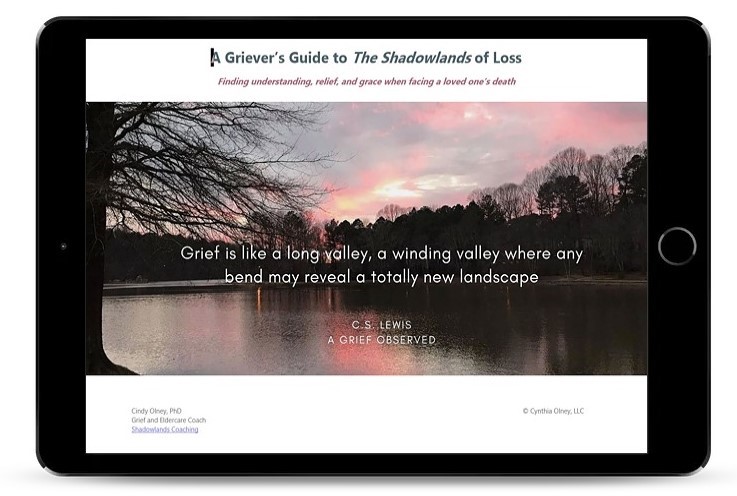“You’re young. You’ll find another husband.”
“At least your loved one is no longer in pain.”
“I know it’s hard, but they’re in heaven now, waiting for you.”
“I bet you’ll be pregnant again in no time.”
Let’s face it. People can say the most insensitive things to grievers.
They’re reaching for solutions for your grief. They want you to see alternatives. Reframe your perspective. Distract you from the darkness of your experience by offering silver linings.
It's infuriating.
Grief isn't a problem that's easily solved through positive thinking.
It’s a life-changing injury that needs lots of attention, time, and care, as well as ongoing support from compassionate friends.
Emotional Storm of Grieving
Grief is an excruciating emotion. It strikes with the heartbreaking realization that you’ve lost someone or something precious and irreplaceable.
In fact, the word bereavement means “to be torn apart.”
Grieving, on the other hand, is the long, arduous process of adapting to life after loss.
I thought I could describe a state; make a map of sorrow. Sorrow, however, turns out to be not a state but a process. ~ CS Lewis, A Grief Observed
Grieving is learning.
Humans are born knowing how to learn and adapt to change.
But grieving is the worst type of learning. Brutal, but mandatory. And flunking out is not an option.
Anytime you’re forced into an unwanted “learning experience,” it surfaces all kinds of intense emotions. On any given day, you may feel…
Fear about being so alone.
Anger over missed opportunities and unwelcome changes.
Anxiety when you realize you don’t know what the future now holds for you.
Relief that the roller coaster of your loved one’s illness is over.
Guilt over your relief.
And/or
Joy that moves you to tears over someone’s empathy and kindness toward you.
Intense emotions are the inevitable reaction to an unwanted cosmic lesson. You can’t escape them. But there are ways to cope with them.
Feel Your Feelings
To get through the worst moments of grieving, you must manage your ability to tolerate intense discomfort.
It’s what life coaches call “feeling your feelings.”
When I first heard that phrase, I thought it was absurd.
I’m highly emotional. I feel my feelings to the point of exhaustion.
Then I realized it wasn’t the feelings that were exhausting me. It was my resistance to them that was wearing me out.
Mindfulness techniques are designed to help you drop your resistance to inner turmoil.
With these techniques, you consciously decide to stop shielding yourself from emotional pain. Instead, you allow the emotions to move through you.
By paying attention, you become familiar with the wave-like energy of emotions. You see how they build, crest, break, and recede.
You find that bouts of emotions only last a minute or two. You can withstand their forceful but short-lived intensity.
Gradually, you learn that waves of emotion won’t, in fact, drown you.
Mindfulness is awareness that arises through paying attention, on purpose, in the present moment, non-judgmentally,” ~ Jon Kabat-Zinn, mindfulness expert and professor emeritus of University of Massachusetts Medical School
I’m a huge fan of the RAIN exercise, particularly the version offered by meditation instructor Tara Brach. This four-step process is easy to learn and remember.
RAIN stands for:
Recognize: Scan your body for tension or physical sensations. We usually first feel emotional reactions physically.
Awareness: Focus your attention on the sensations. See if you can identify the emotions or thoughts causing them. Don’t judge or resist the thoughts and feelings. You can add some psychological distance from your feelings with the phrases that start with “I notice.”
“I notice I’m feeling___” or “I notice I’m thinking_____”
You can also reassure yourself with thoughts such as “It’s okay that I’m feeling_____.”
Investigate: Deeply explore your emotional experience. Ask yourself “What triggered my reaction?” “What are All the emotions I’m feeling right now?” Explore your thoughts, with questions such as “What am I believing about this situation or about myself? And am I right about that?”
Nurture: Talk to yourself compassionately. It may help to talk directly to the hurt part of yourself. Use words that a friend or loved one would say to reassure you, like “It’s okay,” “You’re safe,”
“You’re going to be okay.” You can validate your feelings and thoughts with words like “Of course this hurts you,” or “of course this makes you angry.”
You can also add some nonverbal reassurance by placing your hands on your heart or on the part of your body that feels tense or in pain.
Next Best Step
When I do the four-step RAIN exercise, I like to end it purposefully.
Once I feel the emotions shift, I take a deep breath and ask myself, “What do I need or want to do next?”
The answer depends on the predominant emotion I’ve just experienced.
If it was a wave of grief, I engage in grounding self-care. I drink some water or tea. Take a shower. Walk outside. Turn on some music or watch a funny video.
If it was anger, I decide about how to manage it. Sometimes it means vowing to set a boundary with someone. Sometimes, it’s deciding to let go of an irritating situation.
If it was anxiety, I think about what’s out of my hands and what’s under my control. Then I make a sensible action plan.
Practice Helps
This simple mindfulness technique can become second nature for facing intense emotions. All it takes is a week or two of deliberate practice.
Set aside a specific time to practice it daily. All you need is 10-15 minutes.
Find a quiet place where you won’t be interrupted.
Settle into your seat. Feel where your body is making contact with surfaces. Feel the floor under your feet.
tune into your breathing. Feel the air moving in and out of your lungs.
Then, starting with Recognize, run through the four steps of RAIN.
I always suggest my clients keep pen and paper handy to debrief after the exercise. Take a few moments to jot down the physical sensations, thoughts, and emotions that emerged in the practice. You can also write down your best next steps.
Since learning this technique, I find I can drop into it easily, wherever I am.
By feeling my feelings, my brain slows down. I become less over-reactive. I’m able to set boundaries more easily.
And now that I’m on better terms with my emotions, I take care of my needs more easily.
Holding Space
RAIN is an invaluable tool for those of us who want to show up for our bereaved friends and family members.
Sometimes, we don’t trust our ability to respond calmly to others’ deep grief. As empathetic souls, we feel our feelings and theirs. It’s overwhelming.
We know instinctively that they need our calm presence. We need to allow them to express their grief without interruption. It’s our job to sit with them in their pain, even when we have an overwhelming urge to save them from it.
The RAIN technique will build your confidence in your ability to hold space for intense emotions, both your friend’s and your own.
Feel Grief to Heal It
“We must embrace pain and burn it as fuel for our journey, “wrote Japanese poet Kenji Miyazawa.
The intense emotions of grieving are inevitable. You can’t prevent them or escape them.
You can learn, instead, to steady yourself as they pass through you.
Over time, the waves of emotion will change. They’ll become less frequent. More manageable.
You realize you’re the one that’s changed. You’re stronger. More resilient.
These are qualities that will serve you as you move into your next chapter of life.
So, each time you maneuver through a wave of emotional intensity, take a breath, and remind yourself:
I just healed a little bit more.
Questions about grief coaching?
I'm a grief coach who guides bereaved clients through a resilient grieving process.
My coaching uses proven methods for helping people adapt to life after loss. You’ll learn exactly how to work with intense emotions, so they cause you less suffering. You’ll know how to recognize your own healing progress, giving you hope that life can feel easier again. You'll use your healing journey to get clear on what matters most to you, so you can recreate a life after loss that truly feels worth living. Y
ou can learn more about my program by visiting my Work With Me page. Or check out this short video.
I offer free discovery calls for anyone who wants to meet me and ask questions about my program. These are free informational calls, and there's no obligation to work with me. You can call if you’re interested in working with me or referring me to someone you know.
Working with a grief coach can be game-changing. You can actively engage in your grief and start feeling progress quickly. You can start seeing the possibility of a fulfilling, enjoyable life after loss.

And you don't have to feel so alone. Let’s chat.
Not ready up for a call yet?
Send me an email at cindy@shadowlandscoaching.com.
Get A Griever's Guide to the Shadowlands of Grief
Have you recently lost someone dear to you? Or are you worried about someone who has? Download your free copy of A Griever's Guide to The Shadowlands of Loss. It covers some key elements to grieving and a few helpful strategies that can ease your experience of grief.
